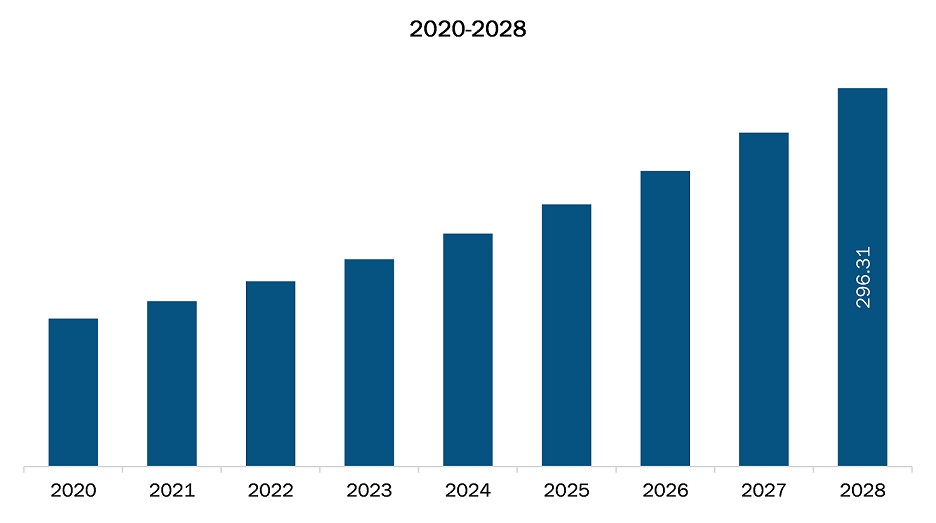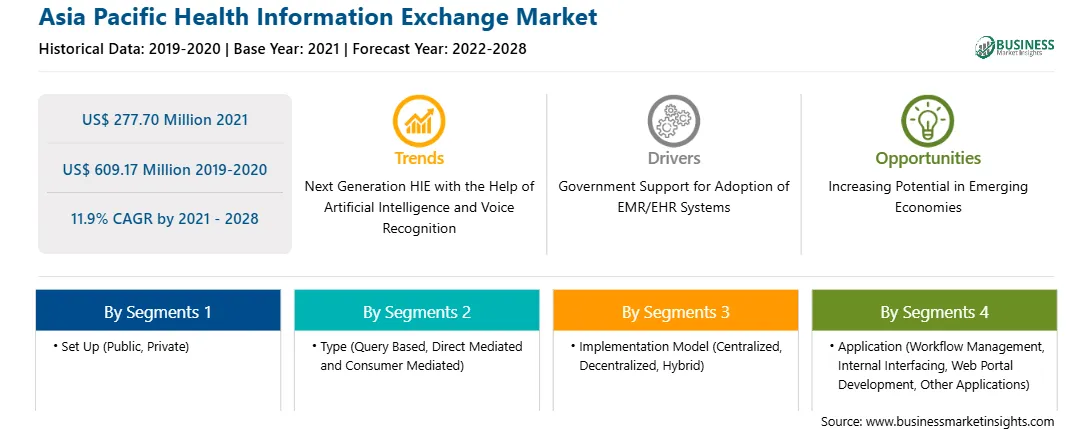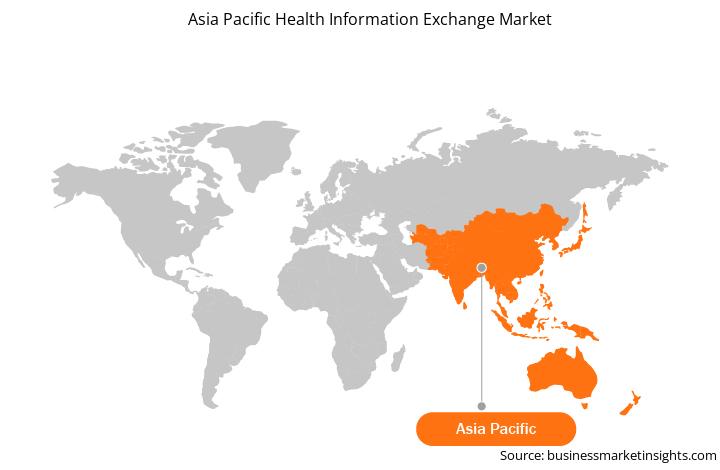Asia Pacific Health Information Exchange Market
No. of Pages: 173 | Report Code: TIPRE00023502 | Category: Technology, Media and Telecommunications
No. of Pages: 173 | Report Code: TIPRE00023502 | Category: Technology, Media and Telecommunications
The Health Information Exchanges (HIEs) are crucial for connecting communities and ensuring patient health records are always available. Healthcare information exchange is an integral and significant element of health information technology (HIT) infrastructure. Healthcare information exchange refers to the deployment of healthcare information electronically.

Strategic insights for the Asia Pacific Health Information Exchange provides data-driven analysis of the industry landscape, including current trends, key players, and regional nuances. These insights offer actionable recommendations, enabling readers to differentiate themselves from competitors by identifying untapped segments or developing unique value propositions. Leveraging data analytics, these insights help industry players anticipate the market shifts, whether investors, manufacturers, or other stakeholders. A future-oriented perspective is essential, helping stakeholders anticipate market shifts and position themselves for long-term success in this dynamic region. Ultimately, effective strategic insights empower readers to make informed decisions that drive profitability and achieve their business objectives within the market.

| Report Attribute | Details |
|---|---|
| Market size in 2021 | US$ 277.70 Million |
| Market Size by 2028 | US$ 609.17 Million |
| Global CAGR (2021 - 2028) | 11.9% |
| Historical Data | 2019-2020 |
| Forecast period | 2022-2028 |
| Segments Covered |
By Set Up
|
| Regions and Countries Covered | Asia-Pacific
|
| Market leaders and key company profiles |
The geographic scope of the Asia Pacific Health Information Exchange refers to the specific areas in which a business operates and competes. Understanding local distinctions, such as diverse consumer preferences (e.g., demand for specific plug types or battery backup durations), varying economic conditions, and regulatory environments, is crucial for tailoring strategies to specific markets. Businesses can expand their reach by identifying underserved areas or adapting their offerings to meet local demands. A clear market focus allows for more effective resource allocation, targeted marketing campaigns, and better positioning against local competitors, ultimately driving growth in those targeted areas.

The Asia Pacific health information exchange market is expected to reach US$ 609.17 million in 2028 from US$ 277.70 million in 2021; it is estimated to grow at a CAGR of 11.9% from 2021 to 2028. The growth of the market is attributed to some key driving factors such as government support for adoption of EMR/EHR systems and growing emphasis on healthcare cost optimization across Europe. However, the data security and privacy concerns are hampering the growth of the market.
Growing emphasis of healthcare cost optimization by the implementation of certain strategies, such as adoption of cloud-based solutions and cutting of hidden fees can provide substantial cost benefits. Such advantages offered by health information exchange are likely to accelerate the growth of health information exchange market during the forecast period. With the fast advancements of healthcare and information technologies, firms from emerging markets have started adopting advanced applications to enhance their productivity and functionalities. Developing nations such as China and India are witnessing an upward trend in health information and exchange applications. The rapid growth of machine learning and deep learning has produced considerable strides in cognitive computing and natural language processing, which are further laying foundations for healthcare information technology adoption. Governments in the emerging countries are actively promoting telemedicine and offering lucrative opportunities for the health information exchange market. According to a study published in NCBI in 2020, the EHR adoption rate in Korea was increased by an estimated 47.0% during the past decade. Such strategic initiatives are likely to offer growth opportunities to market players to attain a significant position and grow in the market.
The Asia Pacific economy is adversely affected due to the exponential increase of COVID-19 cases in the region. Due to the increasing patient volumes, the demand for EMR and EHR platforms to handle complex patient data has grown. As a result, hospitals are progressively focusing on building their capabilities by integrating various hospital systems with EHRs. Players operating in this market have also integrated their EHR platforms with telehealth solutions and upgraded their software solutions to help healthcare providers manage COVID-19 patients effectively. Digital health aided the restriction of the COVID-19 pandemic and supported controlling its worst consequences. Hence, such outbreaks continue the need for new technologically advanced products across Asia Pacific region, positively impacting the market.
The Asia Pacific health information exchange market based on the set up was segmented into public and private. In 2020, the private segment held the largest share of the market, and same segment is expected to grow at the fastest rate during the coming years.
The Asia Pacific health information exchange market, by type, is segmented into query-based, direct mediated, and consumer mediated. The direct mediated segment held the largest share of the market in 2020, and same segment is anticipated to register the highest CAGR in the market during the forecast period.
The Asia Pacific health information exchange market, by implementation model, is segmented into hybrid, centralized, and decentralized. The hybrid segment held the largest share of the market in 2020, also the same segment is anticipated to register the highest CAGR in the market during the forecast period.
The Asia Pacific health information exchange market, by application, is segmented into internal interfacing, web portal development, workflow management and other applications. The web portal development segment held the largest share of the market in 2020. However, internal interfacing segment is anticipated to register the highest CAGR in the market during the forecast period.
Based on end user, the Asia Pacific health information exchange is segmented into healthcare providers, healthcare payers, and pharmacies. The healthcare providers segment held the largest share of the market in 2020 and is estimated to register the highest CAGR in the market during the forecast period.
The Asia Pacific health information exchange market, by deployment, is segmented into on-premises and cloud based. The on-premise segment held the largest share of the market in 2020, however, the cloud-based segment is anticipated to register the highest CAGR in the market during the forecast period.
A few of the primary and secondary sources associated with this report on the Asia Pacific health information exchange market are the Australian Digital Health Agency (ADHA), WA Country Health Service (WACHS) and National Digital Health Mission (NDHM).
The Asia Pacific Health Information Exchange Market is valued at US$ 277.70 Million in 2021, it is projected to reach US$ 609.17 Million by 2028.
As per our report Asia Pacific Health Information Exchange Market, the market size is valued at US$ 277.70 Million in 2021, projecting it to reach US$ 609.17 Million by 2028. This translates to a CAGR of approximately 11.9% during the forecast period.
The Asia Pacific Health Information Exchange Market report typically cover these key segments-
The historic period, base year, and forecast period can vary slightly depending on the specific market research report. However, for the Asia Pacific Health Information Exchange Market report:
The Asia Pacific Health Information Exchange Market is populated by several key players, each contributing to its growth and innovation. Some of the major players include:
The Asia Pacific Health Information Exchange Market report is valuable for diverse stakeholders, including:
Essentially, anyone involved in or considering involvement in the Asia Pacific Health Information Exchange Market value chain can benefit from the information contained in a comprehensive market report.